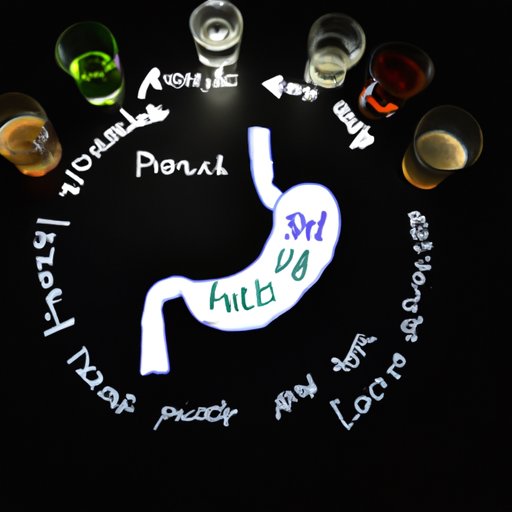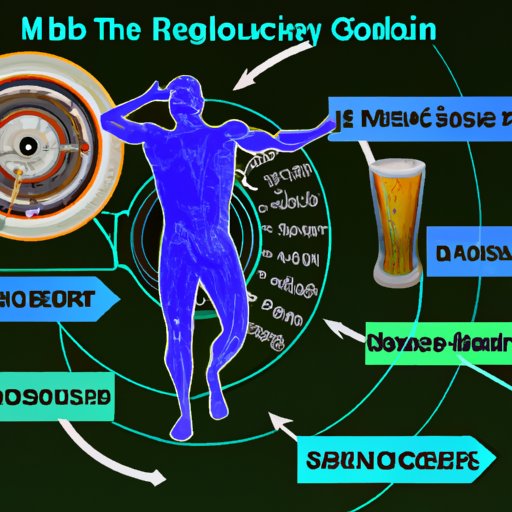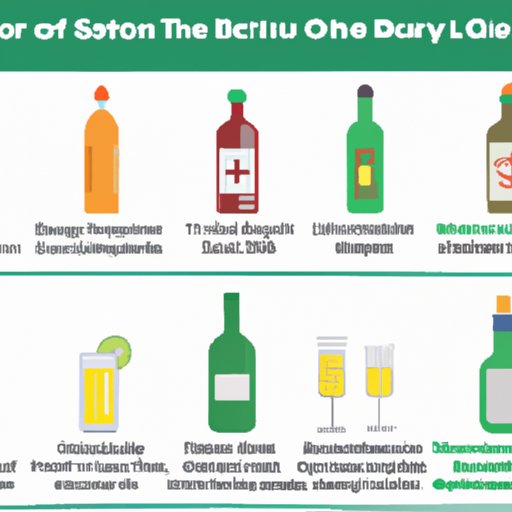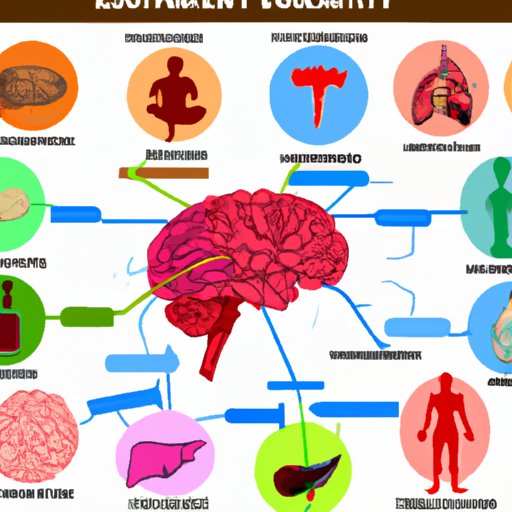Introduction
Alcohol is an intoxicating substance that has been consumed for centuries. While it can be used responsibly, it can also be abused, leading to serious health problems. Understanding how alcohol moves through the body is essential for understanding its effects on the body and the risks associated with excessive consumption.
When consumed, alcohol is absorbed into the bloodstream and circulated throughout the body. It affects the major organs, including the central nervous system (CNS), digestive system, and cardiovascular system. The physiological effects of alcohol vary depending on the amount consumed and the individual’s tolerance level.
Explaining the Physiological Effects of Alcohol on the Body
The CNS controls physical and mental activity, and alcohol has a direct effect on this part of the body. It slows down the functioning of the brain, which results in feelings of relaxation, euphoria, and decreased inhibitions. In larger doses, it can cause confusion, impaired judgment, and loss of coordination.
Alcohol also affects the digestive system. It irritates the lining of the stomach, leading to nausea and vomiting. It can also interfere with the absorption of nutrients and cause dehydration.
Finally, alcohol affects the cardiovascular system. It increases the risk of high blood pressure and can lead to irregular heart rhythms or even cardiac arrest in extreme cases. It can also damage the arteries and veins, leading to an increased risk of stroke or heart attack.

Examining the Pathway of Alcohol Through the Digestive System
When alcohol is consumed, it is absorbed in the stomach and small intestine. The rate at which it is absorbed depends on the type of alcohol consumed, the amount consumed, and the individual’s rate of metabolism. Generally, it takes about 30 minutes for alcohol to be fully absorbed into the bloodstream.
Once in the bloodstream, the alcohol is then transported to the liver where it is metabolized. This process happens slowly and is regulated by enzymes, primarily alcohol dehydrogenase. The liver breaks down the alcohol into acetaldehyde, which is then further broken down into harmless byproducts such as carbon dioxide and water.
Investigating How Alcohol Reaches the Brain
Alcohol must cross the blood-brain barrier in order to reach the brain. This barrier is a selectively permeable membrane that separates the brain from the rest of the body and prevents certain substances from entering the brain. Alcohol is able to pass through this barrier due to its lipid solubility.
Once in the brain, alcohol interacts with neurotransmitters. Neurotransmitters are chemicals that transmit signals between neurons and other cells in the body. Alcohol disrupts the transmission of these signals, resulting in changes in behavior and cognition.

Discussing the Impact of Alcohol on Body Organs
Alcohol can have a damaging effect on various organs in the body. It can lead to short-term effects such as high blood pressure, arrhythmia, and increased risk of stroke. Long-term effects include liver cirrhosis, pancreatitis, and cancer.
The liver is especially vulnerable to the effects of alcohol. Excessive drinking can lead to fatty liver disease, alcoholic hepatitis, fibrosis, and cirrhosis. These conditions can lead to serious health complications and even death.

Breaking Down the Metabolism of Alcohol in the Body
The metabolism of alcohol involves several steps. First, it is broken down by alcohol dehydrogenase, an enzyme found in the liver. This enzyme converts the alcohol into acetaldehyde, a toxic chemical compound. Acetaldehyde is then further broken down by another enzyme, aldehyde dehydrogenase, into harmless byproducts such as carbon dioxide and water.
Finally, the ethanol is oxidized by alcohol oxidase, an enzyme found in the liver, lungs, and kidneys. This process results in the production of energy, which is then used by cells throughout the body.

Understanding the Different Types of Alcohol and Their Effects
Different types of alcohol contain different levels of alcohol content. Beer typically contains around 4-6% alcohol, while wine contains 10-14%. Spirits, such as vodka and whiskey, contain 40-50% alcohol. The higher the alcohol content, the more quickly it is absorbed into the bloodstream.
The type of alcohol consumed also affects the speed at which it is metabolized. Beer and wine take longer to break down than spirits, so they remain in the body longer and can lead to more severe intoxication.
Exploring How Alcohol Affects Cognitive Function
Alcohol can have both short-term and long-term effects on cognitive function. In the short term, it can impair judgement, motor skills, and memory. In the long term, it can lead to permanent cognitive decline, especially in those who drink heavily over a long period of time.
In addition, alcohol can increase the risk of developing dementia and Alzheimer’s disease. It can also lead to depression and anxiety, and can worsen existing mental health conditions.
Conclusion
Alcohol is an intoxicating substance that affects the body in many ways. It is absorbed in the stomach and small intestine before being metabolized by the liver. It then crosses the blood-brain barrier and interacts with neurotransmitters, resulting in changes in behavior and cognition. Different types of alcohol contain different levels of alcohol content, and this can affect the speed at which it is metabolized.
Alcohol can have both short-term and long-term effects on the body. In the short term, it can impair judgement and motor skills. In the long term, it can lead to permanent cognitive decline and an increased risk of developing dementia and Alzheimer’s disease. Therefore, it is important to understand how alcohol moves through the body and the risks associated with excessive consumption.
(Note: Is this article not meeting your expectations? Do you have knowledge or insights to share? Unlock new opportunities and expand your reach by joining our authors team. Click Registration to join us and share your expertise with our readers.)
